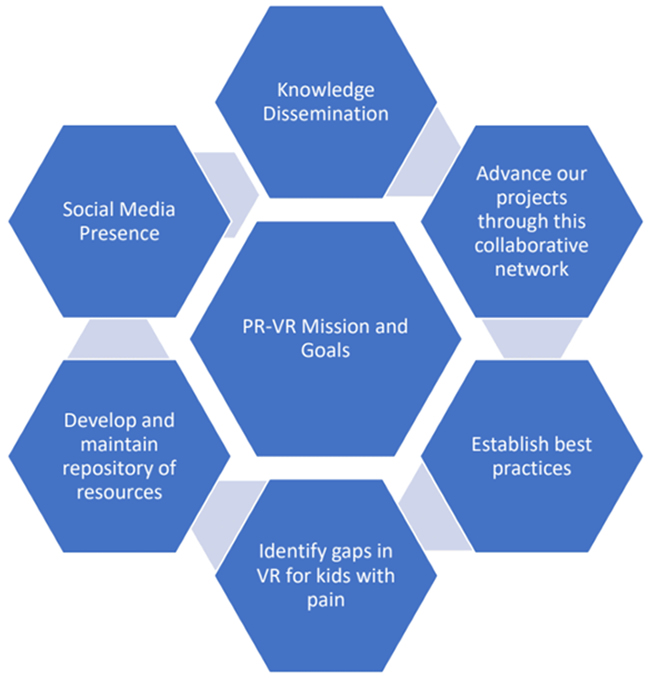Virtual Reality in Pediatric Pain Management
Worlds Away from Pain: Developing Virtual Reality-based Interventions for Pediatric Pain Management
By Deirdre Logan, PhD
Director of Psychology Services in Pain Medicine
Boston Children's Hospital
Associate Professor of Psychology
Department of Psychiatry
Harvard Medical School
Boston, Massachusetts
The past ten years have seen a true explosion in the advances of digital interventions in pediatric healthcare, and the field of pediatric chronic pain is no exception. This time of accelerated innovation then bumped up against the global COVID-19 pandemic and a vast reduction in the availability of in person healthcare, forcing us to delve even further into the space of digital health interventions as a means to bring care to our patients without being in the room with them. Fortunately, we have several strong advantages in pediatrics that enable us to turn toward technology as a source of effective interventions – children are both known for their ability to employ their imaginations and immerse themselves in experiences, and they are digital natives. Technology already surrounds their day-to-day lives; therefore, we can leverage this familiarity to offer a bridge between a world children can easily turn to for comfort and our clinical mission to treat their pain.
A recent landmark Lancet Commission paper presented four transformative goals to improve the lives of children and adolescents with pain and their families: to make pediatric pain matter, make pain understood, make pain visible, and make pain better (Eccleston et al., Lancet Child Adolescent Health 2021). The authors put forth a model for redesigning pain services in healthcare settings. Digital health approaches are central to this model, from “small data”— using technology to measure and communicate individual symptoms and behaviors— to online interventions such as telepsychology, to digital therapeutics such as VR interventions and incorporating the use of “big data” to understand larger patterns and trends.
The current digital landscape for pediatric pain has already established firm roots in the modern healthcare network, with interventions spanning a range of platforms including websites, podcasts, apps, wearables, educational videos and online interventions. Digital interventions for children increase their engagement; children are more immersed within the world of their healthcare, and a general curiosity is sparked by the novelty of a somewhat playful atmosphere. Accessibility is another major hurdle which is overcome by digital interventions, bringing care to those who cannot easily reach the institutions or humans who typically provide it. Digital interventions can enhance patient-centered care by offering more autonomy to the child and their family. These aspects of accessibility and affordability can help overcome many social determinants of health, leading to more equitable healthcare distribution overall. These digital interventions are also portable, which adds to their accessible nature. This investment into technologies for clinical use may spark a proliferation for healthcare products and companies. Additionally, the ongoing pandemic has brought awareness to the need for home-based interventions, which would prove especially useful for families in areas lacking consistent healthcare accessibility.
Virtual reality is a digital platform which holds the potential to provide all benefits described above. Solid research already exists on using virtual reality as a tool for treating pediatric pain. A recent review of VR interventions for pediatric procedural pain finds 106 published studies (Gates et al., Pediatrics Feb. 2020). Most of the published studies on VR in chronic pain have focused on adult populations. Overall, reviews tend to conclude that VR shows promise for reducing pain and improving function in various populations of adults with chronic pain, but many studies are small and not well controlled. The literature on VR in pediatric chronic pain remains quite small. However, given what we know about youth as users of this type of technology, there is good reason to think that this technology may be even more useful for pediatric chronic pain patients.
For a VR intervention to be effective in managing chronic pain, there are important differences to consider from the procedural pain context. To effectively treat chronic pain, VR interventions need to be BROADER IN SCOPE – that is, the interventions need to target more than just pain intensity. Targets should include functioning, which can include physical mobility, quality of life, and other domains, as well as emotional well-being. They must be MORE INTERACTIVE – because the pain itself is longer lasting, the interventions cannot rely on short term distraction from pain. They must truly engage the user in an interactive manner to help them work on pain rehabilitation goals and accomplish the nervous system reprogramming that is so important to successful pain rehab. Additionally, the effects of the intervention must be more ENDURING. They must provide benefit that persists beyond the period of active engagement within the VR environment.
We have begun to grasp some of the important mechanisms and potential effects of VR that go beyond immersive distraction. As reported in a review by Won and colleagues in 2017, VR interventions can amplify the neuromodulating effects of movement therapies (Won et al., Children June 2017). In addition, several small studies have demonstrated techniques for incorporating VR into hypnosis interventions and biofeedback training, helping patients to immerse themselves more fully into these biobehavioral therapeutic techniques. Another important mechanism for the effectiveness of VR in chronic pain treatment has been adapted from work with VR in treating anxiety and post-traumatic stress. This is the use of VR for exposure therapy, or VRET. VRET interventions recognize and harness the power of VR to facilitate pain related movement and overcome fear/behavioral avoidance. Along with the mechanisms of effect, it is important to identify the outcomes VR can target in patients with chronic pain. These are wide ranging and include cognitive, emotional, social, physiological, behavioral, and neurological aspects of the pain experience.
One of the challenges of working in the digital health intervention space is the speed with which technology develops and changes. Working in isolation in the setting of academic medicine, it can be difficult to keep pace with the technology. We run the danger of putting immense time, effort and expense into developing an intervention only to find it is already outdated. Developing collaborative groups can help in this regard – working together across institutions allows us to explore and evaluate new technology more quickly, and we can share resources to make sure interventions are being evaluated consistently and findings disseminated more broadly.
In January 2020, we formed a collaborative group dedicated to the mission of advancing pediatric chronic pain care through virtual reality-based intervention, the Interdisciplinary Network on Virtual/Augmented Technologies for Pain (INOVATE-Pain) group. Our group included representatives from pain programs at several pediatric academic medical centers, a VR software developer who had been working closely with the team at Stanford University on their projects in this area, a VR expert outside of the pain field, and representatives from philanthropy who could help us think about how to support our work. In our initial meeting we developed a set of goals that we seek for our collaborative to achieve (see Figure):

We also identified what we saw as the keys to success in creating effective VR-based pediatric chronic pain interventions. These included: (1) Assembling the right team – thinking about what types of experts are needed to help a project succeed and finding ones that can work together productively; (2) Identifying appropriate intervention goals; (3) Developing a sound approach to outcome evaluation, including appropriate measurement tools; and (4) Implementing a plan for dissemination or reach so that the product reaches the patients and does not remain a one-time academic exercise. This includes attending to feasibility of adopting the intervention in less well-resourced settings.
As an outcome of the initial INOVATE-Pain summit meeting, we published a paper aimed at guiding the field forward in efforts to create effective VR-based interventions for pediatric chronic pain (Logan et al., Journal of Medical Internet Research April 2021). We hope to support one another in further advancing work that has already begun and in developing new innovations (Griffin et al., JMIR Rehabilitation and Assistive Technologies 2020). We also hope to expand our collaborative to work with others who are committed to leveraging the promise of virtual reality technology to address the needs of children and adolescents with chronic pain conditions.
References
- Eccleston, C., Fisher, E., Howard, R. F., Slater, R., Forgeron, P., Palermo, T. M., . . . Wood, C. (2021). Delivering transformative action in paediatric pain: a Lancet Child & Adolescent Health Commission. Lancet Child Adolescent Health, 5(1), 47-87. doi:10.1016/S2352-4642(20)30277-7
- Gates, M., Hartling, L., Shulhan-Kilroy, J., MacGregor, T., Guitard, S., Wingert, A., . . . Ali, S. (2020). Digital Technology Distraction for Acute Pain in Children: A Meta-analysis. Pediatrics, 145(2). doi:10.1542/peds.2019-1139
- Won, A. S., Bailey, J., Bailenson, J., Tataru, C., Yoon, I. A., & Golianu, B. (2017). Immersive Virtual Reality for Pediatric Pain. Children (Basel), 4(7). doi:10.3390/children4070052
- Logan, D. E., Simons, L. E., Caruso, T. J., Gold, J. I., Greenleaf, W., Griffin, A., . . . Wilson, L. (2021). Leveraging Virtual Reality and Augmented Reality to Combat Chronic Pain in Youth: Position Paper From the Interdisciplinary Network on Virtual and Augmented Technologies for Pain Management. Journal of Medical Internet Research, 23(4), e25916. doi:10.2196/25916
- Griffin, A., Wilson, L., Feinstein, A. B., Bortz, A., Heirich, M. S., Gilkerson, R., . . . Simons, L. E. (2020). Virtual Reality in Pain Rehabilitation for Youth With Chronic Pain: Pilot Feasibility Study. JMIR Rehabilitation and Assistive Technologies, 7(2), e22620. doi:10.2196/22620
Acknowledgements
The author thanks the INOVATE-Pain collaborative group who contributed to the ideas presented herein, The Mayday Fund, and Logan McLennan for assistance in preparing this article.




